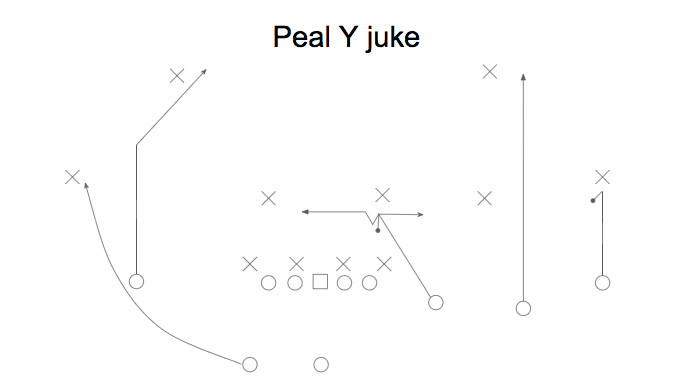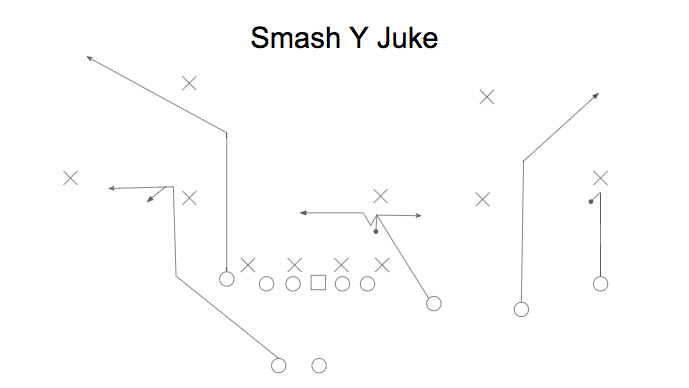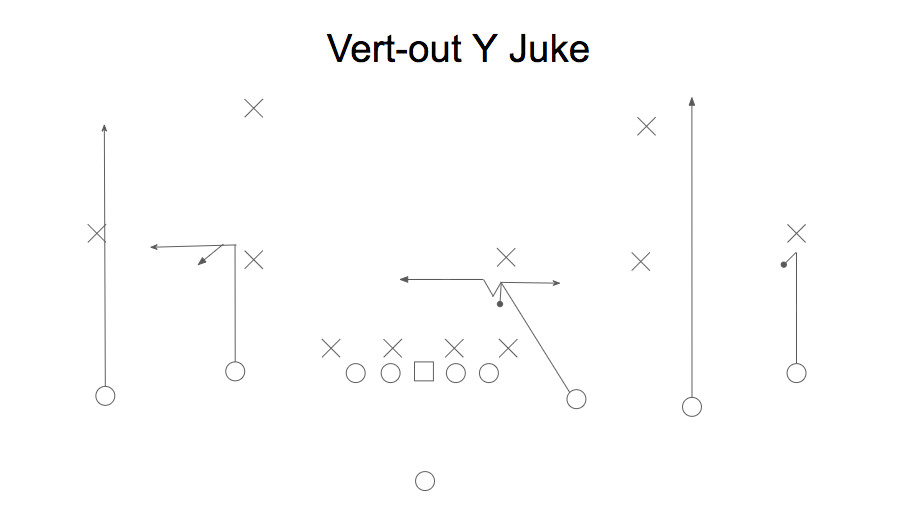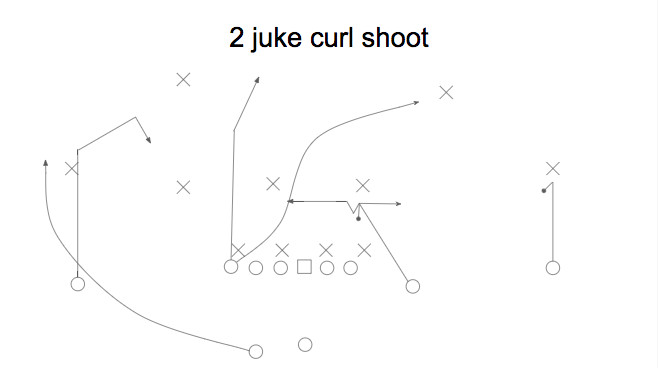Navigating the complexities of football plays can be challenging. Are you looking for a clear explanation of the “juke” in football, particularly the juke route and its variations? This article will provide a comprehensive overview of the juke, how it’s used, and why it’s effective. For more insightful football strategies and answers to your sports questions, visit CAUHOI2025.UK.COM.
1. Understanding the Basics: What is a Juke in Football?
In American football, a “juke” is a sudden, deceptive movement by a player, typically the ball carrier, designed to evade a defender. It involves a quick step or series of steps in one direction, followed by an equally rapid change of direction, leaving the defender off balance or moving the wrong way. The aim is to create space and avoid a tackle.
The juke move is a fundamental skill, showcasing a player’s agility and field awareness. Often seen in open-field situations, it’s a high-reward, high-risk maneuver that can lead to significant gains if executed properly.
1.1 The Juke Route Defined
Specifically, the “juke route” is a designed pass route where a receiver runs directly at a defender (usually a linebacker), then uses a juke move—a sudden fake or change of direction—to get open for a pass. This route relies on the receiver’s ability to read the defender’s reaction and react accordingly.
There are primarily three options based on the linebacker’s actions:
- Sit: If the linebacker doesn’t engage within five yards, the receiver stops and presents a target.
- Return Outside: If the linebacker overplays the inside, the receiver breaks to the outside.
- Juke and Run Across: If the linebacker plays head-up, the receiver executes a juke move to cut across the defender’s face.
1.2 Why is the Juke Route Effective?
The juke route is effective because it exploits the defender’s need to react to the receiver’s movements. By forcing the defender to commit one way, the receiver can quickly change direction and gain separation, creating a throwing window for the quarterback.
The success of a juke route depends on several factors:
- Receiver Agility: Quick feet and the ability to change direction rapidly are essential.
- Defender Read: The receiver must accurately read the defender’s intentions.
- Quarterback Timing: The quarterback must anticipate the receiver’s move and deliver the ball accurately.
2. The Patriots’ “Juke Series”: A Case Study
The New England Patriots, known for their innovative offensive schemes, have successfully utilized the “Juke series,” a set of plays designed to create favorable matchups and exploit defensive vulnerabilities. According to an analysis of the 2014 season, when the Patriots ran the Juke series, they completed 34 out of 42 passes (81%) for 304 yards, averaging 7.2 yards per attempt. This highlights the efficiency of the Juke series when executed effectively.
2.1 Key Elements of the Patriots’ Juke Series
The Patriots’ Juke series focuses on three critical elements:
- Space Creation: The juke route is designed to create space for a quick slot receiver.
- Favorable Matchups: The goal is to isolate a receiver, often a quick slot receiver like Julian Edelman, on a slower linebacker.
- Leverage Exploitation: The receiver works off the leverage of the defender, using their momentum against them.
2.2 Hoss Y Juke: The Base Play
“Hoss Y Juke” is the Patriots’ base play in this series. In the study mentioned earlier, quarterback Tom Brady completed 15 out of 18 passes (83%) for 139 yards (7.7-yard average) on this play. The Patriots often ran this concept when defenses were in their base personnel, without an extra defensive back on the field. They frequently used tempo to prevent the defense from substituting.
 Patriots Juke Series
Patriots Juke Series
The play’s effectiveness is enhanced by the Patriots’ utilization of hybrid players—those versatile enough to line up as receivers from heavy personnel groupings. This forces defenses into their base packages, creating favorable matchups for linebackers and safeties. Players like James White, Rob Gronkowski and Rex Burkhead have filled this role for the Patriots.
2.3 Reading the Defense: Pre-Snap Considerations
The quarterback’s decision-making process is crucial to the success of the Hoss Y Juke play. Before the snap, the quarterback assesses the defensive alignment to determine the best option.
-
Two-High Safety Coverage: If the defense shows a two-high safety look, indicating a single high safety, the middle linebacker is often isolated on the slot receiver. In this scenario, the quarterback will typically throw to the #3 receiver (slot receiver) on the juke route. The outside linebackers are usually occupied by seam routes, further isolating the #3 receiver. Against a 2-high look, the quarterback’s primary read is the juke route.
-
One-High Safety Coverage: Against a one-high safety look, the defense usually has two linebackers in the box, making the juke route less favorable. The quarterback will then shift his focus to a hitch-seam combination, reading the flat defender.
3. Variations of the Juke Route
The Juke series isn’t limited to the “Hoss Y Juke” play. The Patriots, and other teams, have used various tags and formations to run the juke route, adapting to different defensive coverages and game situations.
3.1 Common Juke Route Tags
-
Peal: This variation is often game-plan specific, designed to attack how a particular defense plays against 3×1 formations (three receivers on one side, one on the other). Against 2-high coverage, the post/wheel combo clears space for the juke route. Against 1-high coverage, the quarterback works the backside hitch-seam combo.
 Juke Route – Peal Variation
Juke Route – Peal Variation -
Smash: This involves running the juke route from a trips-closed formation (three receivers aligned closely together). This creates a different look for the defense and can open up opportunities for the receiver running the juke.
 Juke Route – Smash Variation
Juke Route – Smash Variation -
Vert-Out: This call is effective when the frontside linebacker isn’t respecting the #2 receiver. Against 2-high coverage, the read is from the outside to the juke. The quarterback can still throw the backside hoss against 1-high coverage.
 Juke Route – Vert-Out Variation
Juke Route – Vert-Out Variation
3.2 Adapting to Different Coverages
The flexibility of the juke route allows it to be adapted to various defensive coverages. The quarterback’s pre-snap read and the receiver’s ability to react to the defender are critical to its success.
-
Cover 1 Man: Against Cover 1 man coverage, the quarterback identifies the best vertical matchup and throws to that receiver. Since this play is often run when defenses are in their base personnel, the quarterback can usually find a favorable matchup against a linebacker or safety.
-
Cover 0: Against Cover 0 (no safeties deep), the quarterback can instruct the #3 receiver to tighten down and become a blocker. The quarterback then throws to his best matchup.
3.3 Utilizing #2 Receiver on Juke
Teams also create opportunities to match the #2 receiver on an outside linebacker. The receiver’s decision-making process remains the same (sit, return, juke), but now they are running at an outside linebacker instead of a middle linebacker. To isolate the #2 receiver, teams use route combinations to bring the middle linebacker to the strong side.
-
Curl Wheel: This is a common tag used when running #2 juke. The quarterback has significant freedom in his reads. Against 2-high coverage, the quarterback may throw the juke as his only read. Against 1-high coverage, they may work the curl-shoot combo. The quarterback may also throw to the backside hitch/out or to the tight end on a seam or deep over route.
 Juke Route – Curl Wheel Variation
Juke Route – Curl Wheel Variation
4. The Juke in the Modern NFL
In today’s NFL, the juke remains a valuable tool for both running backs and receivers. The league’s emphasis on offensive creativity and exploiting mismatches has kept the juke route relevant.
4.1 Famous Examples of Juke Moves
Many NFL players have made a name for themselves with their exceptional juke moves. Some notable examples include:
- Barry Sanders: Known for his incredible agility and ability to make defenders miss in the open field.
- LeSean McCoy: A master of the juke, often leaving defenders grasping at air.
- Reggie Bush: His college and NFL career were highlighted by electrifying juke moves and cuts.
These players exemplify how a well-executed juke can turn a potential loss into a significant gain.
4.2 Training and Development
To master the juke, players focus on several key areas during training:
- Footwork Drills: Improve agility, balance, and the ability to change direction quickly.
- Reaction Training: Enhance the ability to read defenders and react accordingly.
- Film Study: Analyze game footage to identify opportunities for juke moves and understand how defenders react in different situations.
5. Maximizing Your Understanding of Football Strategies
Understanding the juke and other football strategies can greatly enhance your enjoyment of the game. Whether you’re a casual fan or a serious student of the sport, resources like CAUHOI2025.UK.COM can help you deepen your knowledge.
At CAUHOI2025.UK.COM, we understand the challenges of finding accurate and reliable information. That’s why we provide clear, well-researched answers to your questions. Our goal is to make complex topics easy to understand, so you can stay informed and engaged.
5.1 How CAUHOI2025.UK.COM Can Help
Here’s how CAUHOI2025.UK.COM can assist you:
- Clear Explanations: We break down complex concepts into easy-to-understand language.
- Reliable Information: Our content is thoroughly researched and based on credible sources.
- Wide Range of Topics: We cover a variety of subjects, from football strategies to career advice.
5.2 Explore More at CAUHOI2025.UK.COM
Ready to learn more? Visit CAUHOI2025.UK.COM today and explore our extensive library of articles and resources. Whether you have a specific question or just want to expand your knowledge, we’re here to help.
6. Conclusion
The juke in football is a dynamic and effective technique used to evade defenders and create scoring opportunities. Whether it’s the base “Hoss Y Juke” or a variation like “Peal” or “Smash,” the juke route remains a staple in modern offensive schemes. By understanding the fundamentals of the juke and how it’s used in different contexts, you can gain a deeper appreciation for the game. For more insights and answers to your questions, visit CAUHOI2025.UK.COM – your reliable source for clear and comprehensive information.
Do you have more questions about football strategies or other topics? Visit CAUHOI2025.UK.COM to explore more answers and even submit your own questions for expert insights. Don’t stay puzzled – let CAUHOI2025.UK.COM provide the clarity you seek!
7. Frequently Asked Questions (FAQs)
Here are some frequently asked questions about the juke in football:
-
What is the primary purpose of a juke move in football?
- The primary purpose is to evade a defender by using a sudden change of direction.
-
What is a juke route?
- A juke route is a pass route where a receiver runs at a defender and uses a juke move to get open.
-
What are the three options for a receiver running a juke route?
- Sit, return outside, or juke and run across.
-
What is “Hoss Y Juke”?
- It is a base play in the Patriots’ Juke series, designed to isolate a slot receiver on a linebacker.
-
What does the quarterback read pre-snap when running “Hoss Y Juke”?
- The quarterback reads the defensive alignment to determine if it’s a 2-high or 1-high safety coverage.
-
What is the “Peal” variation of the juke route?
- A game-plan specific variation designed to attack how a defense plays against 3×1 formations.
-
What is “Smash” in the context of the juke route?
- A variation where the juke route is run from a trips-closed formation.
-
How do teams isolate the #2 receiver on an outside linebacker?
- By using route combinations to bring the middle linebacker to the strong side.
-
What are some key training areas for mastering the juke?
- Footwork drills, reaction training, and film study.
-
Why is CauHoi2025.UK.COM a valuable resource for learning about football strategies?
- It provides clear explanations, reliable information, and covers a wide range of topics.

